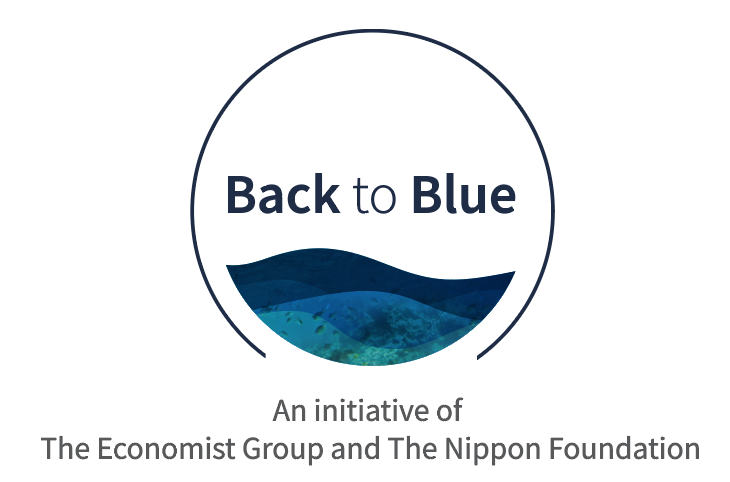The Economist Group and The Nippon Foundation Launch New Initiative to Promote Ocean HealthBack to Blue project to address ocean pollution

Back to Blue is a new initiative from the Economist Group and The Nippon Foundation that is being launched today at the Economist Group’s eighth annual World Ocean Summit. With an initial focus on ocean pollution, the three-year collaboration seeks to address the escalating challenges posed by pollution from plastic debris and, less visibly, pollution from nutrients and chemical contaminants that are damaging ocean life and ecosystems, and in turn human health. The specific program is currently being developed based on the findings of a Back to Blue global survey (see below), which identified plastic pollution (59.6% of respondents) and chemical pollution (39.1%) as the top two concerns, followed by climate change (31.1%).
The opportunity to embark on original research, stimulate fresh dialogue, and explore new solutions to the vexing problems posed by pollution in the ocean is motivating both organizations. The Economist Group, through its World Ocean Initiative and World Ocean Summit, has been fostering a global conversation on the greatest challenges facing the seas. The Nippon Foundation, with its diverse range of programs that includes building and nurturing ocean networks, research, and professionals, has a global reputation for championing ocean science and health. The Back to Blue initiative brings together two organizations that share a common understanding of the need for evidence-based approaches and solutions to the pressing issues faced by the ocean, offering a powerful platform from which to accelerate momentum for improving ocean health.
During remarks at the signing of a memorandum of understanding between the two organizations, The Nippon Foundation Chairman Yohei Sasakawa noted, “We are much aware of the land-based problems that occur around us,” and warned, “However, when it comes to understanding the multifaceted problems of the ocean that covers 70% of the earth surface, I believe that our understanding is still very poor. This is already a threat to human security for every individual on this planet.”
Echoing these sentiments, Paul Deighton, chairman of the Economist Group, said, “We [at the Economist Group] have also developed our own passion for the ocean. We held our first World Ocean Summit in 2012, after we had argued in the newspaper that the seas were in trouble, and that human activities were having a profound impact on ocean health. A decade or so later we are more committed than ever to our vision of an ocean in robust health and with a vital economy. The ocean is too big to fail.”
Discussing the Back to Blue initiative at the launch event, Charles Goddard, editorial director at the Economist Group, noted that “defining and heading towards a pollution-free ocean is an enormous challenge, as we are already seeing in the many extraordinary efforts to address plastic pollution. We hope Back to Blue can contribute vital new knowledge and perspectives on contaminants in the ocean, and to the global architecture of engagement needed to address them. The urgency is very real.”
About the Back to Blue global survey
In January 2021, the Economist Group and The Nippon Foundation jointly undertook two related surveys – one of industry and public-sector executives, the other of the general public (global citizens) – to gain a better understanding of their views and priorities with regard to key ocean issues. The survey was conducted to provide a reference point for the Back to Blue initiative among the global audience the project expects to engage, as well as to seek feedback on the direction and relevance of the initiative, and to help gauge progress toward its goals.
Survey details:
Survey 1. Industry and Public Sector
Sample size: 1,000
Geography: 20% each from North America, Europe, and Asia-Pacific, and 40% from the rest of the world
Employment status: Full-time or part-time employees
Type of organization respondents work for:
70% from for-profit organizations (a range including a minimum of 50 each from finance, food (including fisheries) and beverage, travel (including shipping) and tourism, and energy
30% from public sector or non-profit organizations, or academia
Survey 2. General Public / World Citizens
Sample size: 3,000
Geography: 20% each from North America, Europe, and Asia-Pacific, and 40% from the rest of the world
Age: 50% Millennials (born 1981-96) and Generation Z (1997-) / 50% Generation X (1965-80) and Baby Boomers (1946-64)
Gender: At least 40% male and 40% female
Related link
Contact
Sandpiper Communications
- Email: EIU@sandpipercomms.com
Public Relations Team
The Nippon Foundation
- Email: cc@ps.nippon-foundation.or.jp



